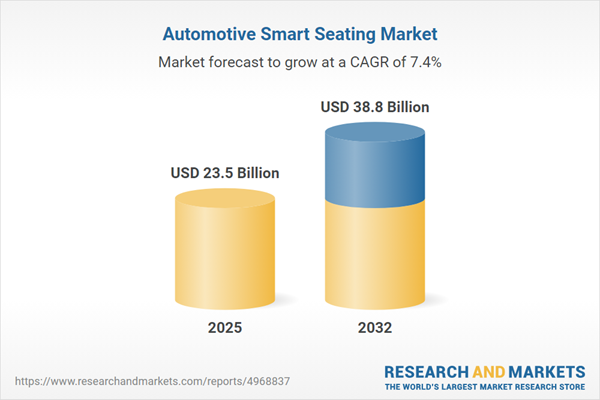Speak directly to the analyst to clarify any post sales queries you may have.
The automotive smart seating market is rapidly advancing as connected, intelligent interiors become essential for delivering differentiated in-vehicle experiences. Senior decision-makers need granular insight into evolving technologies, regulatory impacts, and actionable opportunities shaping this sector’s future competitiveness.
Market Snapshot: Automotive Smart Seating Market Size and Growth Dynamics
The Automotive Smart Seating Market grew from USD 21.97 billion in 2024 to USD 23.50 billion in 2025. It is forecasted to continue expanding at a CAGR of 7.36%, reaching USD 38.80 billion by 2032. This growth is fueled by rising demand for enhanced occupant comfort, advanced driver assistance features, and adaptive, connected in-cabin technologies.
Scope & Segmentation of the Automotive Smart Seating Market
This report offers comprehensive coverage of all core aspects influencing the automotive smart seating market, including:
- Components: Cushion, Electronic Control Units, Seating Systems
- Connectivity: 5G, Bluetooth, Wi-Fi integration
- Seating Position: Front Seats, Rear Seats
- Technology: Connected Seating, Gesture & Voice Control, Sensor-Based Seating
- Application: Active Monitoring (Driver Assistance Alerts, Sensor Based Monitoring), Impact Protection, User Interaction
- Vehicle Type: Commercial Vehicles, Passenger Vehicles
- End User: Automotive OEMs, Fleet Operators, Individual Consumers, Ride-Sharing Services
- Distribution Channel: Aftermarket, OEM
- Region: Americas (including United States, Canada, Mexico, Brazil, Argentina, Chile, Colombia, Peru), Europe, Middle East & Africa (including United Kingdom, Germany, France, Russia, Italy, Spain, Netherlands, Sweden, Poland, Switzerland, United Arab Emirates, Saudi Arabia, Qatar, Turkey, Israel, South Africa, Nigeria, Egypt, Kenya), Asia-Pacific (including China, India, Japan, Australia, South Korea, Indonesia, Thailand, Malaysia, Singapore, Taiwan)
- Key Companies: Adient PLC, Aisin Seiki Co., Ltd., Bostik SA, Brose Fahrzeugteile GmbH & Co. KG, Continental AG, ESI Group, Faurecia SE, Gentherm Inc., Gentherm Incorporated, GRAMMER AG, Hyundai Motor Group, Johnson Controls International PLC, Lear Corporation, Magna International Inc., Mitsubishi Electric Corporation, Recaro Automotive GmbH, TACHI-S Co.,Ltd., Tata Elxsi Ltd., Toyota Boshoku Corporation, TS TECH Co., Ltd., Yanfeng International Automotive Technology Co., Ltd.
Key Takeaways: Critical Insights for Senior Decision-Makers
- The integration of sensor-driven smart seating transforms vehicle interiors from static to responsive environments, enabling real-time health monitoring, gesture, and voice-based adjustments.
- Automakers are prioritizing advanced materials, modular designs, and intuitive interfaces to address user comfort, ergonomic safety, and in-cabin connectivity demands.
- Investment in domestic manufacturing and supplier diversification is increasing, prompted by shifting global trade policies and the need for resilient supply chains.
- Competitive advantage is now shaped by the ability to deliver context-aware, data-driven seating experiences in line with evolving regulations and regional user preferences.
- Collaborative innovation among OEMs, technology vendors, and semiconductor providers is essential for accelerating time-to-market of adaptive seating solutions.
Tariff Impact: Implications of U.S. Automotive Tariffs
Recent U.S. automotive tariffs have resulted in increased costs for imported raw materials and electronic components, leading to reevaluation of existing sourcing models. Manufacturers are responding by exploring localized production, optimizing electronic module efficiency, and pursuing alternate supplier partnerships to reduce exposure and increase resilience within the automotive smart seating supply chain.
Methodology & Data Sources
The research combines interviews with senior executives, product engineers, and regulatory experts with secondary analysis of technical reports, regulatory filings, and industry consortium documentation. Data triangulation, patent monitoring, and shipment tracking provide quantitative rigor, while panel validation ensures findings accurately reflect real-world conditions.
Why This Report Matters: Actionable Strategic Value
- Enables decision-makers to benchmark emerging smart seating trends and technology integrations with segment-level granularity.
- Identifies market-access challenges, regulatory shifts, and partner opportunities critical for long-term competitive planning.
- Delivers practical recommendations for supply chain optimization, local production strategies, and product innovation that align with evolving end-user expectations in global markets.
Conclusion: Navigating the Future of Connected Automotive Interiors
The automotive smart seating market is entering a phase of accelerated transformation, marked by digitalization, user-centric design, and regulatory complexity. Strategic agility and collaborative innovation will be key for industry leaders seeking to shape next-generation vehicle interiors.
Additional Product Information:
- Purchase of this report includes 1 year online access with quarterly updates.
- This report can be updated on request. Please contact our Customer Experience team using the Ask a Question widget on our website.
Table of Contents
3. Executive Summary
4. Market Overview
7. Cumulative Impact of Artificial Intelligence 2025
Companies Mentioned
The companies profiled in this Automotive Smart Seating market report include:- Adient PLC
- Aisin Seiki Co., Ltd.
- Bostik SA
- Brose Fahrzeugteile GmbH & Co. KG
- Continental AG
- ESI Group
- Faurecia SE
- Gentherm Inc.
- Gentherm Incorporated
- GRAMMER AG
- Hyundai Motor Group
- Johnson Controls International PLC
- Lear Corporation
- Magna International Inc.
- Mitsubishi Electric Corporation
- Recaro Automotive GmbH
- TACHI-S Co.,Ltd.
- Tata Elxsi Ltd.
- Toyota Boshoku Corporation
- TS TECH Co., Ltd.
- Yanfeng International Automotive Technology Co., Ltd.
Table Information
| Report Attribute | Details |
|---|---|
| No. of Pages | 192 |
| Published | November 2025 |
| Forecast Period | 2025 - 2032 |
| Estimated Market Value ( USD | $ 23.5 Billion |
| Forecasted Market Value ( USD | $ 38.8 Billion |
| Compound Annual Growth Rate | 7.3% |
| Regions Covered | Global |
| No. of Companies Mentioned | 22 |









